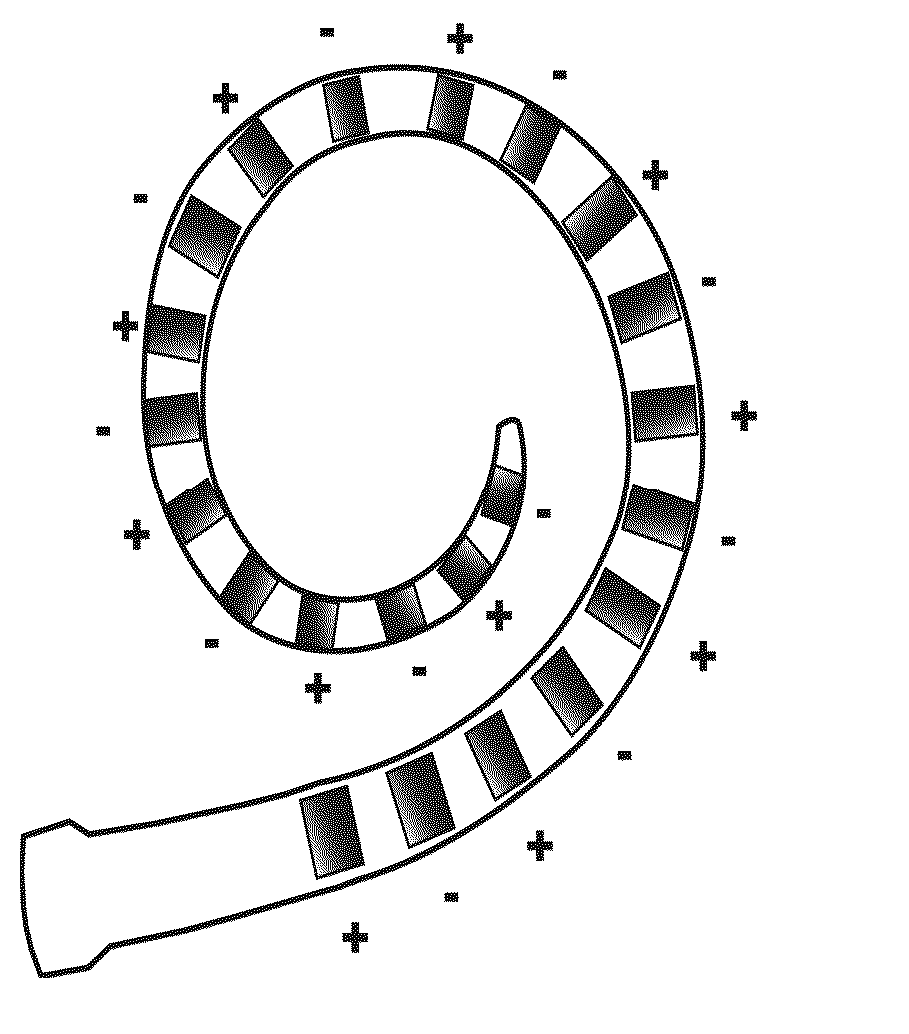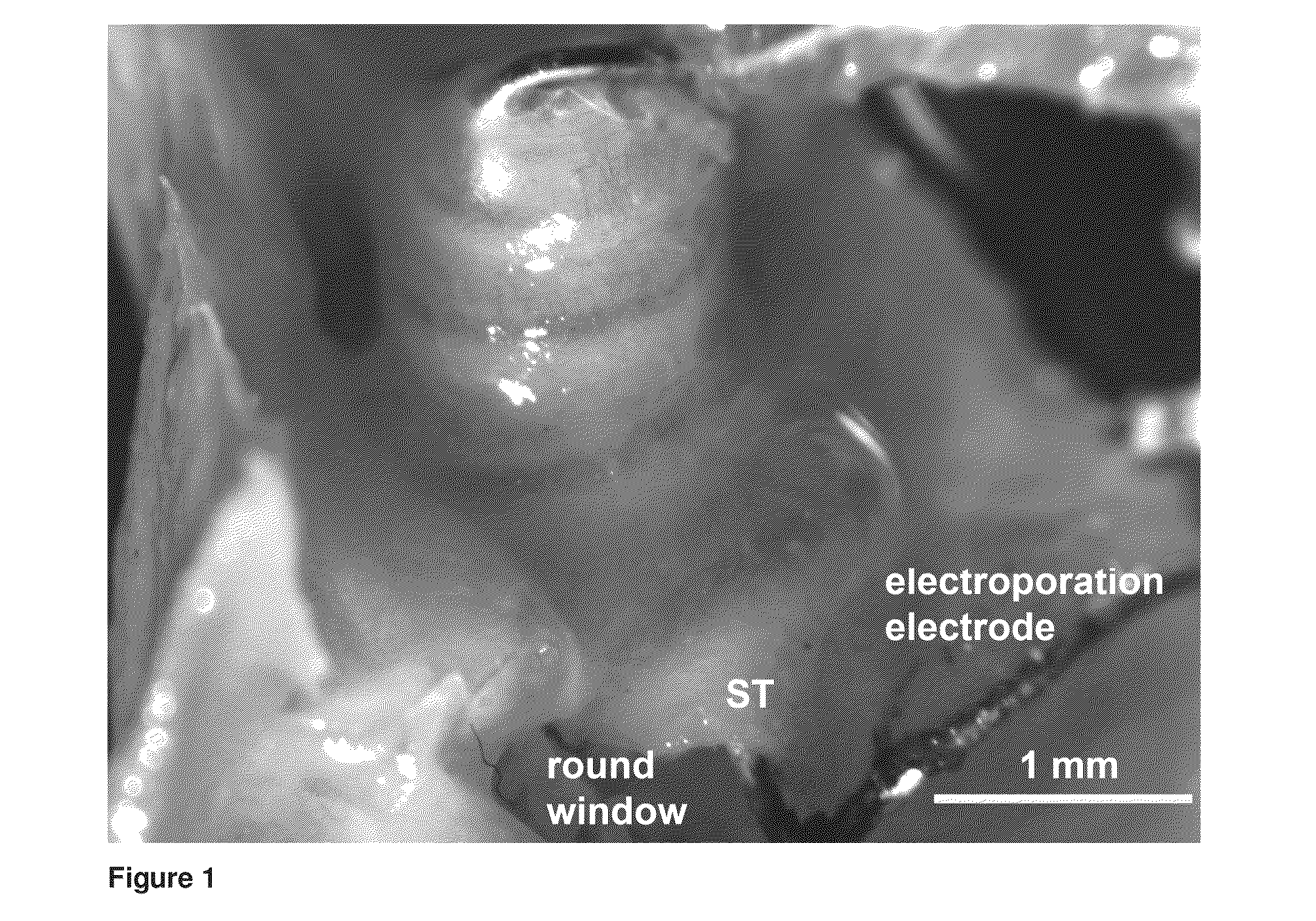Method of providing agents to the cochlea
a technology of cochlea and agent, which is applied in the direction of artificial respiration, genetic material ingredients, therapy, etc., can solve the problems of degeneration of peripheral processes, death of spiral ganglion neurons, and limit the degree to which agents may provide support to cochlear tissue, so as to improve the subsequent performance of cochlear implant neural prosthesis
- Summary
- Abstract
- Description
- Claims
- Application Information
AI Technical Summary
Benefits of technology
Problems solved by technology
Method used
Image
Examples
example 1
Electroporation Transfection of Cochlear Mesenchymal Cells In Situ
[0109]Experiments were carried out to determine whether pulsed electrical fields of a specific profile, delivered via electrodes placed in the cochlea of a guinea-pig, could provide localized transfection of specific gene constructs in the mesenchymal cells lining the cochlear scala tympani. One of two different naked cDNA gene constructs were introduced into each cochlea. The cDNA gene constructs utilized commercial bicistronic expression vectors where fluorescence reporter proteins and therapeutic molecules were jointly expressed via an IRES (internal ribosome entry site) element, and expression was driven by the cytomegalovirus promoter (CMVp).
[0110]The two cDNA constructs were:
[0111]1. CMVp-TRPC3-IRES-DsRed2
[0112]a. The plasmid (pIRES2-DsRed2 (Clontech™), including the IRES bicystronic expression element and the DsRed2 fluoroescence reporter.
[0113]b. The TRPC3 gene (Accession no. AB090949.1) element was cloned fro...
example 2
Assessment of Neuro Protection Provided by Cochlear Cell Transfection
[0127]A guinea-pig model is employed to study the ability of electroporetic transfection of a polynucleotide construct encoding a spiral ganglion trophic factor to support the survival of spiral ganglion neurons.
[0128]Cochlear sensory hair cells are destroyed using a single co-administration of kanamycin (400 mg / kg provided subcutaneously) and frusemide (100 mg / kg intravenously, causing a progressive loss of the cochlear (spiral ganglion) neurons in following weeks.
[0129]After kanamycin / frusemide treatment, a solution comprising an expression cassette, such as the cassettes described in Example 1, encoding a spiral ganglion cell neurotrophic factor, for example any one of glial cell line-derived neurotrophic factor, brain-derived neurotrophic factor, neurotrophin-3, neurotrophin-4 / 5, and ciliary neurotrophic factor, is introduced to the cochleae of the anaesthetised guinea pigs. Electrodes inserted into the scala t...
example 3
Use of a Cochlear Implant to Transfect Cochlear Cells by Electroporation
[0131]Guinea-pigs are deafened by selective lesion of the cochlea hair cells using kanamycin / frusemide as described in Example 2, and undergo chronic cochlear implantation, via the round window for functional validation of the efficacy of cochlear implant-mediated electroporation gene delivery. A nucleic acid molecule which encodes a neurotrophic factor for spiral ganglion neurons, for instance in the form of an expression cassette as described in Example 1 which also comprises a reporter molecule, or which modulates endogenous neurotrophic factor expression is delivered into scala media immediately prior to, or with the implantation of a cochlear implant prosthesis and then electroporation occurs by delivering high field strength current through the cochlear implant prosthesis electrode array. The array is left in place and the wound closed. The nucleic acid molecule is selected from nucleic molecules comprisin...
PUM
| Property | Measurement | Unit |
|---|---|---|
| concentration | aaaaa | aaaaa |
| volume | aaaaa | aaaaa |
| volume | aaaaa | aaaaa |
Abstract
Description
Claims
Application Information
 Login to View More
Login to View More - R&D
- Intellectual Property
- Life Sciences
- Materials
- Tech Scout
- Unparalleled Data Quality
- Higher Quality Content
- 60% Fewer Hallucinations
Browse by: Latest US Patents, China's latest patents, Technical Efficacy Thesaurus, Application Domain, Technology Topic, Popular Technical Reports.
© 2025 PatSnap. All rights reserved.Legal|Privacy policy|Modern Slavery Act Transparency Statement|Sitemap|About US| Contact US: help@patsnap.com



